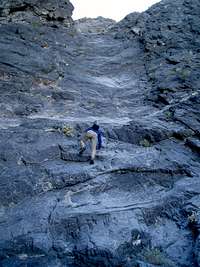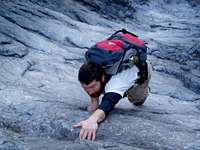-
 6062 Hits
6062 Hits
-
 83.69% Score
83.69% Score
-
 17 Votes
17 Votes
|
|
Route |
|---|---|
|
|
36.20565°N / 116.33057°W |
|
|
Scrambling |
|
|
Spring, Fall, Winter |
|
|
Half a day |
|
|
Class 4 |
|
|
Overview
This is a direct route up the West Face of Eagle Mountain. It provides a great alternative to the main route, with some more spicy scrambling.Getting There
See the main Eagle Mountain page for this info.Route Description
From the parking area, there are three prominent chutes which pierce the West Face of Eagle Mountain, just north of the summit. They converge at the alluvial fan beneath them. Head across the Amargosa River, and up the bajada to the base of the 3 distinct chutes. This is the same approach as for the main route. (see route topo image on header of this page)Instead of using the ramp on the left of the 3rd chute (which is the standard West Face route), find your way to the base of the middle chute. It is the deepest of the chutes, usually in the shade somewhat, with a polished dryfall in the middle of it. There are a few mid-size boulders to be surmounted to allow entry into the chute, but it's Class 2 travel to the base.
Some fun scrambling up the chute will take you to the main event- the dryfall. The main dryfall is probably 150' of climbing. It's Class 4, honest, though some might call it easy Class 5, but it's fairly easy, with very secure and ample holds on very solid rock. The exposure (obviously) increases as one nears the top. The crux of the entire route is the last move to pull to the top of the dryfall. Staying to the left provides easier access, but The Move requires a short dynamic pull- commitment. You can see the move in the picture to the right. It's easier than it looks but it will get hearts pounding and some parties will want a rope or piece of webbing lowered from the top as a handhold.
Above the dryfall, the chute widens considerably. Bailing onto the standard route is easy here, by traversing left over a rib and onto the main route ramp. In the wider part of the chute, pick your way up. This is more Class 4 rock, and again the rock quality is great, though more solid and smooth in the direct watercourse. The rest of the chute described here consists of several small steps (15') separated by longer (25'+) low angle slabs.
After several hundred more vertical feet, you will meet the standard route on the ramp that ascends after the standard route crosses the white band. Ascend this ramp for a little ways, but continue up to the base of the cliffs. The standard route will continue traversing right toward the saddle on the main ridge. To continue the "Direct" route, go up another set of dryfalls, making a gradual ascending traverse along ribs to the saddle itself. This will add some more Class 4 scrambling to the mix, and is quite enjoyable.
From the saddle, there are two options. One is to take the use trail which traverses up and to the right, and then take the spur ridge to get on top of the North Ridge. Another option is to ascend the ridge directly to the South, all the way to the summit. The ridge straight from the spur is a bit of a pain in the butt- broken rock and so forth. The final 1/5th of a mile of immaculate knife-edge scrambling on the North Ridge makes the whole climb worth it. You will go up and down gendarmes and larger towers, but the scrambling never gets worse than exposed Class 3. Eventually, you will come to the summit. Enjoy!





